The avian world is a tapestry of vibrant hues, but sometimes, the most striking beauty lies in the elegant contrast of black and white. Within the diverse family of Thrushes (Turdidae), several species captivate with their monochromatic yet intricate plumage, offering a visual feast for birdwatchers and nature enthusiasts alike. These “Black And White Thrushes,” though not a formal scientific classification, represent a fascinating group where dark and light patterns play a pivotal role in their identity and allure. This article delves into the characteristics of thrushes and highlights some of the most prominent species that showcase these captivating black and white features, exploring their unique appearances, habitats, and behaviors across continents.
Understanding Thrushes: General Characteristics
Thrushes, belonging to the Order Passeriformes and Family Turdidae, are generally recognized as plump, soft-plumaged birds of small to medium size. They are commonly found inhabiting wooded areas, where they often forage for food on the ground or consume small fruits. While many species typically exhibit gray or brown coloration, often with speckled underparts, the presence of speckles is particularly common in juveniles, even if absent in adults. Thrushes are primarily insectivorous, but their diet frequently includes worms, snails, and various fruits.
Their nesting habits involve constructing cup-shaped nests, sometimes reinforced with mud, where they lay clutches of two to five speckled eggs. It’s common for thrushes to produce multiple clutches per year, and both parents actively participate in raising their young. Beyond their physical traits and behaviors, thrushes are celebrated for their vocal prowess; the songs of some species are widely regarded as among the most melodious and beautiful sounds in the natural world.
Iconic Black and White Thrushes of the Old World
The Old World, encompassing Europe, Asia, and Africa, is home to a remarkable array of thrushes, many of which exhibit a stunning interplay of black and white in their feathers. These species often stand out against their varied landscapes, from dense forests to mountainous regions, with their distinctive plumages.
The Common Blackbird (Turdus merula)
Perhaps one of the most well-known species exhibiting a strong black coloration is the Common Blackbird. Native to Europe, Asia, and Africa, and introduced to Australasia, the male of this species is entirely black, distinguished by a bright yellow eye-ring and a contrasting yellow bill. The female, in contrast, displays dark brown plumage, often with some mottling on the breast, a faint yellow eye-ring, and a yellow bill. Though predominantly black, its striking yellow features provide a vivid contrast, making it an excellent example of a bird defined by its stark, dark appearance. Common Blackbirds are also renowned for their beautiful and rich song, which is a familiar sound in many European gardens and parks. They can be differentiated from the Indian Blackbird by the latter’s longer and broader eye-rings, and from the Tibetan Blackbird which lacks the yellow eye-ring.
The White-collared Blackbird (Turdus albocinctus)
A more direct embodiment of the “black and white thrush” description is the White-collared Blackbird, found in various parts of Asia. This species is characterized by its predominantly black plumage, dramatically offset by a prominent white band around its neck, resembling a collar. This distinct feature makes it easily identifiable and a captivating sight for birdwatchers.
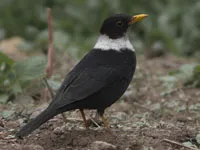 White-collared Blackbird with striking black plumage and a clear white neck band in India
White-collared Blackbird with striking black plumage and a clear white neck band in India
The Ring Ouzel (Turdus torquatus)
Found in Europe, particularly in mountainous regions, the Ring Ouzel offers another magnificent example of black and white contrast. This species has mainly black plumage, with noticeable white feather edging on its underparts. The male is particularly striking, featuring a distinct white crescent shape across its breast. The female is similar but tends to be duller in coloration, while juveniles are typically brown and may lack the iconic white crescent. Often considered the mountain counterpart to the Common Blackbird, the Ring Ouzel’s striking appearance helps it stand out in its rugged habitats.
The Dusky Thrush (Turdus eunomus)
The Dusky Thrush, inhabiting parts of Europe (including Ukraine) and Asia, presents a fascinating blend of colors that includes significant black and white elements. It features brown upperparts and rufous wings, but its face is notably black, complemented by a broad white supercilium (an eyebrow-like stripe) and a white throat. Its white belly is adorned with distinct black spots, and it possesses a black bill with a yellow base. The combination of black on the face and throat, along with the contrasting white supercilium and speckled underparts, makes it a noteworthy “black and white thrush.”
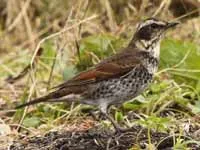 Dusky Thrush perched on a branch, showing its broad white supercilium and speckled underparts in Japan
Dusky Thrush perched on a branch, showing its broad white supercilium and speckled underparts in Japan
Striking Black and White Thrushes of Asia
Asia, a continent with vast and varied ecosystems, is home to additional thrush species that prominently display black and white patterns, contributing to the rich biodiversity of its avian populations.
Japanese Thrush (Turdus cardis)
The Japanese Thrush, an Asian species, features a predominantly black plumage in males, beautifully contrasted by a white belly marked with distinctive black spots. This elegant pattern gives it a sophisticated appearance, making it a favorite among bird enthusiasts. Females and juveniles often exhibit browner upperparts, providing sexual dimorphism within the species. This thrush is a classic example of how black and white patterns can create a visually appealing and easily recognizable bird.
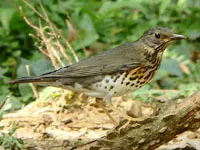 Japanese Thrush male with mostly black plumage and a white, black-spotted belly in Taiwan
Japanese Thrush male with mostly black plumage and a white, black-spotted belly in Taiwan
Black-throated Thrush (Turdus atrogularis)
The Black-throated Thrush, found across Europe and Asia, is another species defined by its stark black and white features. The male boasts gray upperparts, but its throat and upper-breast are a deep black, contrasting sharply with a whitish lower-breast and belly. Females and immatures display similar patterns, though the solid black is replaced by dusky streaking, creating a softer, yet still distinct, black and white effect. These birds are often seen in open woodlands and shrublands, where their striking plumage can be observed as they forage.
White-backed Thrush (Turdus kessleri)
The White-backed Thrush, also known as Kessler’s Thrush, found in Asia, is a particularly striking example of a “black and white thrush.” Its most defining characteristic is a pristine white back and belly, which stands in stark contrast to its otherwise black plumage. This dramatic coloration makes it an unforgettable sight and a prime representation of the black and white theme. Its bold patterns highlight the diversity of thrush plumages.
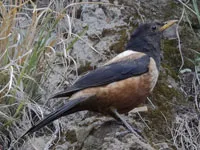 White-backed Thrush showcasing its stark white back and belly against black plumage
White-backed Thrush showcasing its stark white back and belly against black plumage
Other Thrushes with Contrasting Markings
While some thrushes are predominantly black and white, others feature these colors as significant accents, contributing to their unique appearance and adding to the overall diversity of the family.
Fieldfare (Turdus pilaris)
The Fieldfare, a migratory thrush found in Europe, Asia, and northern Africa (rarely in North America), presents a complex plumage that includes notable white sections. It has plain brown upperparts, with darker wings and tail. Its breast and flanks are heavily spotted, often with a reddish wash, while the rest of its underparts are distinctly white. This combination of brown, reddish, and white, with dark spots, makes for a bird with clear contrasting features, where the white underparts play a significant role in its overall look.
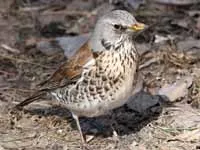 Fieldfare perched on a branch, displaying its brown upperparts and spotted white underparts
Fieldfare perched on a branch, displaying its brown upperparts and spotted white underparts
Mistle Thrush (Turdus viscivorus)
The Mistle Thrush, common across Europe and Asia, and introduced to parts of Africa and Australia, is another species where black markings on a lighter background create a distinctive appearance. It has gray-brown upperparts, with a grayish-white chin and throat, and a pale eye-ring. Its yellowish-off-white underparts are heavily adorned with bold black spots, giving it a beautifully speckled look. This intricate pattern, especially the prominent black spots against a pale belly, makes it a noteworthy “black and white” example within the broader thrush family.
Beyond Plumage: Behavior and Habitat
The black and white thrushes, like their more colorful relatives, exhibit a range of fascinating behaviors and occupy diverse habitats. Their diets are varied, typically consisting of insects, worms, and fruits, which they forage for by hopping on the ground or searching through foliage. Many thrush species are known for their territorial nature, especially during breeding season, and their melodious songs serve not only to attract mates but also to delineate their territories.
These birds occupy a variety of ecological niches. Species like the Ring Ouzel prefer the rugged terrain of mountains, while the Common Blackbird thrives in a mix of woodlands, gardens, and urban parks. The Japanese Thrush and Black-throated Thrush often frequent forests and shrublands, showcasing their adaptability to different environments. Their presence is a vital part of many ecosystems, contributing to seed dispersal and insect control, underscoring their ecological importance beyond their striking appearance.
Conservation and Appreciation
While the provided source does not detail the specific conservation status of each species, general appreciation and observation of these birds contribute to broader conservation efforts. Understanding the habitats and behaviors of black and white thrushes, and thrushes in general, is crucial for protecting them and their environments. Many species face challenges from habitat loss and climate change, making it more important than ever to observe and support efforts that ensure their survival.
By taking the time to learn about these beautiful birds, we can foster a deeper connection with the natural world. Their unique black and white plumages are a testament to the incredible diversity of life and a reminder of the subtle beauty that can be found in simple contrasts.
Conclusion
The world of thrushes is rich with variety, and the “black and white thrush” category offers some of the most visually captivating examples. From the classic elegance of the Common Blackbird to the striking collar of the White-collared Blackbird, and the dramatic patterns of the Ring Ouzel and Japanese Thrush, these birds demonstrate how a limited palette can create extraordinary beauty. Their diverse appearances, coupled with their melodious songs and vital ecological roles, make them a truly special group within the avian kingdom. As you observe birds in your local environment or learn about species from distant lands, take a moment to appreciate the intricate beauty of these black and white wonders, and consider the important role they play in the tapestry of life.
